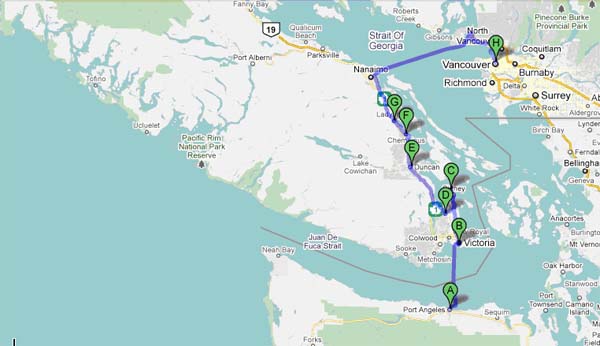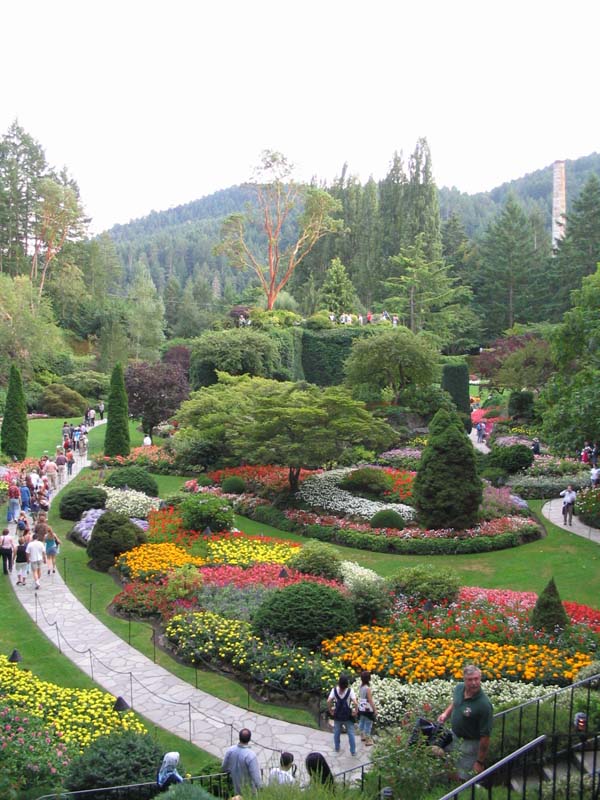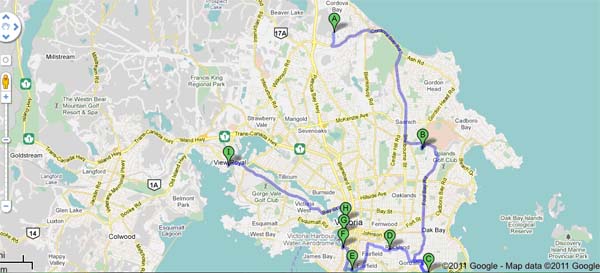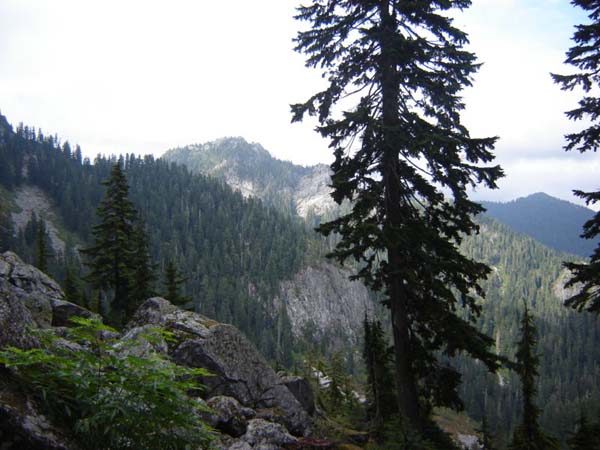The Travels of a Journalistâ€â€ÂÂ60-Four nights in British Columbia bring us memories of Australia
Posted on March 9th, 2011
By Shelton A. Gunaratne ƒÆ’-¡ƒ”š‚©2011Professor of mass communications emeritus@ Minnesota State University Moorhead
Monday (28 Aug, 1989) morning, weƒÆ’‚¢ƒ¢-¡‚¬ƒ¢¢”š¬‚Carmel, 5; Junius, 9; Yoke-Sim and IƒÆ’‚¢ƒ¢-¡‚¬ƒ¢¢”š¬‚left the Olympic Peninsula of Washington from Port Angeles (pop. 18,397), the biggest city in the peninsula, by ferry and landed in Victoria (pop. 78,000) in British Columbia (pop. 4.4 million), Canada. The current population of Canada is 34 million,
On arrival at Port Angeles ferry terminal, we lined up our car for rhe 12.45 p.m. ferry ride to Victoria on MV Coho. (In 1989, our ferry ride cost us $32, including $23 for the car. Today, the same package would cost $86, including $39.50 for the car. ) Then, until the ferryƒÆ’‚¢ƒ¢-¡‚¬ƒ¢-¾‚¢s departure time, we visited the Port Angeles courthouse, library and several downtown shops.
The 40-km (25-mile) ferry ride to Victoria, across the Strait of Juan de Fuca, took 90 minutes. The ride turned out to be great fun for Carmel and Junius, who observed the waters of the strait from all angles of the ferry. Because none us used Sri Lanka passports, the Canada immigration had no reason to deny us entry to the country. But we recalled the fuss that the Canada consul general in Seattle created when we sought a travel visa for my sister ƒÆ’‚¢ƒ¢-¡‚¬ƒ…-RaniƒÆ’‚¢ƒ¢-¡‚¬ƒ”š‚ barely a fortnight ago.
British Columbia (BC) was so named by Queen Victoria in 1858. It became the sixth province of Canada in 1871. Victoria, at the southern tip of Vancouver Island (Figure 1), is the capital of the province. However, the metropolitan area of Greater Victoria has a population of 330,000ƒÆ’‚¢ƒ¢-¡‚¬ƒ¢¢”š¬‚translating to about 45 percent of the people who live on the 32,694 sq km Vancouver Island. Vancouver (pop. 578,041) on the mainland is the provinceƒÆ’‚¢ƒ¢-¡‚¬ƒ¢-¾‚¢s largest city. The metropolitan area of Vancouver, however, has a population of more than 2.1 million.
Figure 1: Our route from Port Angeles, WA, through Vancouver Island to Vancouver, BC
A=Port Angeles. WA, -Victoria, BC, Ferry; B=Victoria, capital of BC; C=MacDonald Provincial Park (northern tip of Saanich Peninsula; D=Butchart Gardens; E=Duncan; F=Chemainus; G=Ladysmith; H=Nanaimo-Vancouver City Ferry.
So, whom shall we call by the demonym VancouveriteƒÆ’‚¢ƒ¢-¡‚¬ƒ¢¢”š¬‚a resident of Vancouver city or of Vancouver Island? Apparently, the people of British Columbia are so proud of their British colonial heritage that they have retained the name that Queen Victoria gave their province, as well as the name of their capital city named for her. Moreover, despite the confusion, they have retained the name of their island and their largest city named after Capt. George Vancouver (1757-1798), the famous British explorer of the Pacific Coast.
Victoria Attractions
It was sunny when we landed in VictoriaƒÆ’‚¢ƒ¢-¡‚¬ƒ¢-¾‚¢s Inner Harbor, where the Trans-Canada Highway 1 begins on the western edge of Beacon Hill Park. We lost no time and drove 500 meters from the Ferry Ramp to the Parliamentary Buildings to join the 3 p.m. tour.
After learning about the Parliamentary system of governance in British Columbia, we moved on to see a few more attractions in and around the Heritage Court:
ƒÆ’‚¢ƒ¢-¡‚¬ƒ”š‚¢ Thunderbird Park, a part of the Royal British Columbia Museum Cultural Precinct. The park is home to many totem poles (mostly Gitxsan, Haida, and Kwakwaka’wakw) and other First Nations monuments.
ƒÆ’‚¢ƒ¢-¡‚¬ƒ”š‚¢ The 62-bell Netherlands Centennial Carillon in front of the Royal BC Museum. A gift of the Dutch community of BC, the carillon was placed in 1967 to commemorate CanadaƒÆ’‚¢ƒ¢-¡‚¬ƒ¢-¾‚¢s Centennial Year.
ƒÆ’‚¢ƒ¢-¡‚¬ƒ”š‚¢ The renovated turn-of-the century Empress Hotel, where visitors can enjoy their afternoon tea in the hotel’s historic Tea Lobby. Served with scones, afternoon tea is a British ritual familiar in Australia New Zealand as well. It reminded us of our decade in Australia. In our eyes, we could have easily imagined ourselves to be in Adelaide, Brisbane, Melbourne, Perth or Sydney. We were having a whale of a time in Victoria, the city in BC (although we could have confused it with the state of the same name in Australia)
We spent the late afternoon in the 14-hectare Butchart Gardens (800 Benvenuto Ave.) in Brentwood Bay, 23 km north of downtown Victoria. (Current summer admission is $29 per adult plus 12 percent harmonized sales tax.) The gardens, founded by Robert P. Butchart (1856-1943) and his wife Jennie at the turn of the century, attract more than a million visitors annually. It is a visual delight of flowers and shrubs. We were delighted to feast our eyes on its different floral gardensƒÆ’‚¢ƒ¢-¡‚¬ƒ¢¢”š¬‚Japanese, Rose, Sunken, Italian and so forth; the Star Pond; the Concert Lawn; and the Show Greenhouse. We saw the Ross Fountain at its best with its lights on at night. We ate a picnic dinner and waited to see the ƒÆ’‚¢ƒ¢-¡‚¬ƒ…-Just for FunƒÆ’‚¢ƒ¢-¡‚¬ƒ”š‚ stage show at 8.30 p.m. It was well worth our money. In addition, the gardens offer a collection of statuary and of birds to enhance its ambience.
ƒÆ’-¡ƒ”š‚
We feasted our eyes on the several floral gardens at the Butchart Gardens. The Sunken Gardens was one of our favorites (27 May 2008).
Source: Wikimedia Commons. Photo by W. Bardwin]
We drove 18 km northeast from Butchart Gardens to camp overnight at the 20-hectare McDonald Provincial Park (in Sidney, a variation of Sydney, Australia): a very attractive, wooded campground facility located a short distance from the Swartz Bay ferry terminal, just off Highway 17 on the Saanich Peninsula.
Because the attractions we visited were not far from one another, our driving distance during the day was a mere 59 km (37 miles).
Tuesday (29 Aug.), we widened our area of exploration from the top to the bottom of Saanich Peninsula, which encompasses two of the 15 most populous municipalities in BC: Saanich and Victoria. In the morning, after we checked out of MacDonald campgrounds, we visited the ferry terminal at Swartz Bay; cruised the top of the peninsula along Lands End Road; then drove all the way south on West Saanich Road (Route 17A); turned east on Keating Cross Road to join Patricia Bay Highway 17; and stopped at Cordova Bay to see the Fable Cottage Estate, a fairytale home with an animated ƒÆ’‚¢ƒ¢-¡‚¬ƒ…-fantasy forest.ƒÆ’‚¢ƒ¢-¡‚¬ƒ”š‚ This owner-built private estate was open to tourists during the summer months. Knotted beams, barrel doors, crafted hand-adzed furniture and family heirlooms were some of the intriguing features of the Fable Cottage.
[Since our visit in 1989, Fable Cottage has disappeared from its location in Cordova Bay. Its new location is Denman Island, north of Nanaimo and south of Comox, on the Strait of Georgia.]
Driving further south, we stopped at Mount Tolmie Park for a good view of Victoria. From its 120-meter summit, we had a sweeping, 360-degree view of Saanich, Victoria, the Olympic Mountains and Mount Baker. On the way up, we saw a number of man-made structures and natural pathways through rocky outcrops to explore. A Garry oak mountain meadow along the trail provides an ideal place for picnicking.
Then, via Richmond Avenue, we drove further south to the two-hectare Gonzales Hill Regional Park with hopes of visiting the Gonzales Observatory (built in 1914). Unfortunately, it was closed.
ƒÆ’-¡ƒ”š‚
Figure 2: Selected Attractions in City of Victoria, BC (29 Aug. 1989)
A=Cordova Bay (Fable Cottage re-located on Denman Island, BC); B=Mount Tolmie; C=Gonzales Hill; D=Government House Gardens; E=Beacon Hill Park; F=Parliament Buildings/Inner Harbor Ferry Terminal; G=Bastion Square; H=Chinatown; I=Trans-Canada Highway 1 to Nanaimo-Vancouver Ferry Terminal.
From the Observatory, we went to see the modern Tudor style Government House and Gardens (1401 Rockland Ave.), the official residence of the lieutenant governor of British Columbia (currently Steven Point). Fire destroyed the first mansion in May 1899. Wikipedia elaborates that the walls of the present T-shaped structure ƒÆ’‚¢ƒ¢-¡‚¬ƒ…-are of rusticated blue, grey and pink British Columbia granite with Haddington Island stone trim, and the roof, which is two storeys high in itself, has steeply pitched, chalet-style gables and numerous dormer windows.ƒÆ’‚¢ƒ¢-¡‚¬ƒ”š‚ The 14.6 -hectare property associated with Government House is divided into a multitude of zones by plant life or garden style. Thus, the British Columbia native plant garden contains species unique to the province.
We ate our lunch at Beacon Hill Park, about two kilometers away from the Inner Harbor Ferry Ramp where we landed the day before. The 62-hectare park is elegantly landscaped and manicured with bridges, lakes and ponds, and an alpine and rock garden. Carmel and Junius enjoyed the parkƒÆ’‚¢ƒ¢-¡‚¬ƒ¢-¾‚¢s ChildrenƒÆ’‚¢ƒ¢-¡‚¬ƒ¢-¾‚¢s Farm attraction. We admired the 40-meter totem pole carved out of cedar by Chief Mungo Martin (1879-1962), alias Nakapenkem, a major contributor to KwakwakaƒÆ’‚¢ƒ¢-¡‚¬ƒ¢-¾‚¢wakw art, particularly wood sculpture and painting. The totem pole stood as another park attraction from 1956 to 2000.
In the early afternoon, we explored the Bastion Square overlooking the Victoria harbor, where British colonial governor and fur trader James Douglas (1803-1877) first established Fort Victoria in 1843. Thanks to City Planner Roderick Clack, Bastion Square became an important heritage precinct in Victoria from the 1960s. It was the northern edge of Fort Victoria and became the centre of civic life during the gold-rush era and afterwards. Some of its buildings are among the oldest in Old Town and many are landmark structures in the city.
In a walking tour starting at the City Hall from Centennial Square, we went through Chinatown, the oldest one of its kind in Canada. The focal point of Chinatown is the 500-600 block of Fisgard Street, including famously narrow Fan Tan Alley, the old Chinese School and a small selection of historic buildings and Chinese businesses. The visit to E.A. Morris tobacconist shop since1892 was of special interest to me because it brought memories of my fatherƒÆ’‚¢ƒ¢-¡‚¬ƒ¢-¾‚¢s addiction to Jaffna-made suruttus (cigars).
Trans-Canada Highway
We realized that the law of diminishing returns was affecting our ability to enjoy all our hectic explorations. We had to start our journey on the Victoria-Winnipeg section of the Trans-Canada Highway (Highway 1) now because our schedule required us to leave Vancouver Island by evening, and camp the night in the North Shore Mountains of Vancouver in the mainland.
The Trans-Canada Highway, uniformly designated as Highway 1 in the four western provinces, begins in Victoria, BC, at the intersection of Douglas Street and Dallas Road (where the “Mile 0” plaque stands) and passes northward along the east coast of Vancouver Island for 99 km (62 miles) to Nanaimo (pop. 78,692).
So we left downtown Victoria, got on Highway 1, and drove to Nanaimo stopping at three places on the way: Duncan (pop. 5,000), Chemainus (pop. 4,100) and Ladysmith (pop. 7,538). In Duncan, we saw the Glass Castle from outside. In Chemainus, we saw the wall murals of downtown buildings. In Ladysmith, we bought ice cream from a Malaysian vendor. In Nanaimo, we saw the Petroglyph (rock inscription) Park before we reached the ferry terminal. (Some call Nanaimo the “Hub, Tub and Pub City” because of its association with the bathtub racing and the numerous “watering holes” in Old Nanaimo.
From Nanaimo, we took the 7 p.m. ferry to cross the Strait of Georgia to Horseshoe Bay in West VancouverƒÆ’‚¢ƒ¢-¡‚¬ƒ¢¢”š¬‚a distance of 48 km (30 miles). Our total fare was $29.
From West Vancouver, we drove 31 km east-northeast on Highway 1, past North Vancouver, to reach the 3,508-hectare Mount Seymour Provincial Park (estbd. 1936), via Mount Seymour Parkway. We camped in the ski area at the top with a beautiful view of Vancouver at night. For the record, we drove 220 km during the day.
View of the eastern flank looking north: Mount Seymour Provincial Park, Vancouver, BC (September 2006).
Source: Wikimedia Commons. Flank Photo by Keith Freeman]
(To be continued)



